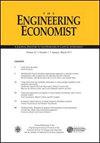First-year undergraduate students’ economic decision outcomes in engineering design
IF 1.2
4区 经济学
Q4 BUSINESS
引用次数: 0
Abstract
Abstract Economic decisions are a crucial part of the engineering design process as designers aim to minimize the cost and maximize the system’s benefits. This study focuses on first-year undergraduate students’ economic decision-making process when they trade off costs and benefits during a design challenge. In addition, we characterized students’ patterns of outcomes derived from economic decisions using the cost-benefit analysis (CBA) method during the design process. Our results suggest that students took different approaches, such as being conservative, moderately conservative, moderate, and aggressive when they tradeoff their design goals. Implications of this study relate to (a) the characterization of different approaches for trading-off design goals and (b) the use of the cost-benefit analysis method as a tool to assess students’ final designs to decide which alternative design is better. In addition, students can use the CBA method to make informed decisions while designing to optimize their design solutions.工程设计中一年级本科生的经济决策结果
摘要经济决策是工程设计过程中的一个关键部分,因为设计者的目标是最小化成本,最大限度地提高系统的效益。这项研究的重点是一年级本科生在设计挑战中权衡成本和收益时的经济决策过程。此外,在设计过程中,我们使用成本效益分析(CBA)方法对学生从经济决策中得出的结果模式进行了表征。我们的研究结果表明,学生在权衡设计目标时采取了不同的方法,如保守、适度保守、适度和积极。这项研究的意义涉及(a)权衡设计目标的不同方法的特征,以及(b)使用成本效益分析方法作为评估学生最终设计的工具,以决定哪种替代设计更好。此外,学生可以使用CBA方法在设计时做出明智的决定,以优化他们的设计解决方案。
本文章由计算机程序翻译,如有差异,请以英文原文为准。
求助全文
约1分钟内获得全文
求助全文
来源期刊

Engineering Economist
ENGINEERING, INDUSTRIAL-OPERATIONS RESEARCH & MANAGEMENT SCIENCE
CiteScore
2.00
自引率
0.00%
发文量
14
审稿时长
>12 weeks
期刊介绍:
The Engineering Economist is a refereed journal published jointly by the Engineering Economy Division of the American Society of Engineering Education (ASEE) and the Institute of Industrial and Systems Engineers (IISE). The journal publishes articles, case studies, surveys, and book and software reviews that represent original research, current practice, and teaching involving problems of capital investment.
The journal seeks submissions in a number of areas, including, but not limited to: capital investment analysis, financial risk management, cost estimation and accounting, cost of capital, design economics, economic decision analysis, engineering economy education, research and development, and the analysis of public policy when it is relevant to the economic investment decisions made by engineers and technology managers.
 求助内容:
求助内容: 应助结果提醒方式:
应助结果提醒方式:


